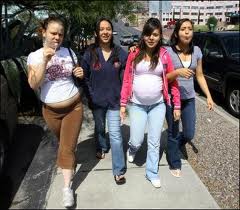 In 2009, a total of 409,840 infants were born to 15−19 year olds, for a live birth rate of 39.1 per 1,000 women in this age group. Nearly two-thirds of births to women younger than age 18 and more than half of those among 18−19 year olds are unintended. The US teen birth rate fell by more than one-third from 1991 through 2005, but then increased by 5 percent over two consecutive years. Data for 2008 and 2009, however, indicate that the long-term downward trend has resumed. The U.S. teen pregnancy and birth, sexually transmitted diseases (STDs), and abortion rates are substantially higher than those of other western industrialized nations.
In 2009, a total of 409,840 infants were born to 15−19 year olds, for a live birth rate of 39.1 per 1,000 women in this age group. Nearly two-thirds of births to women younger than age 18 and more than half of those among 18−19 year olds are unintended. The US teen birth rate fell by more than one-third from 1991 through 2005, but then increased by 5 percent over two consecutive years. Data for 2008 and 2009, however, indicate that the long-term downward trend has resumed. The U.S. teen pregnancy and birth, sexually transmitted diseases (STDs), and abortion rates are substantially higher than those of other western industrialized nations.
Teen pregnancy and childbearing bring substantial social and economic costs through immediate and long-term impacts on teen parents and their children.
Teen pregnancy accounts for more than $9 billion per year in costs to U.S. taxpayers for increased health care and foster care, increased incarceration rates among children of teen parents, and lost tax revenue because of lower educational attainment and income among teen mothers. Pregnancy and birth are significant contributors to high school drop out rates among girls. Only about 50% of teen mothers receive a high school diploma by age 22, versus nearly 90% of women who had not given birth during adolescence.
The children of teenage mothers are more likely to have lower school achievement and drop out of high school, have more health problems, be incarcerated at some time during adolescence, give birth as a teenager, and face unemployment as a young adult. These effects remain for the teen mother and her child even after adjusting for those factors that increased the teenager’s risk for pregnancy; such as, growing up in poverty, having parents with low levels of education, growing up in a single-parent family, and having low attachment to and performance in school.
Teen pregnancy prevention is one of the Center for Disease Prevention and Control's (CDC) top six priorities, a “winnable battle” in public health and of paramount importance to health and quality of life for our youth.
Evidence-based teen pregnancy prevention programs typically address specific protective factors on the basis of knowledge, skills, beliefs, or attitudes related to teen pregnancy. Topics that should be included in a pregnancy prevention programs are:
- Knowledge of sexual issues, HIV, other STDs, and pregnancy (including methods of prevention).
- Perception of HIV risk.
- Personal values about sex and abstinence.
- Attitudes toward condoms (pro and con).
- Perception of peer norms and behavior about sex.
- Individual ability to refuse sex and to use condoms.
- Intent to abstain from sex, or limit number of partners.
- Communication with parents or other adults about sex, condoms, and contraception.
- Individual ability to avoid HIV/STD risk and risk behaviors.
- Avoidance of places and situations that might lead to sex.
- Intent to use a condom.
Non-Hispanic black youth, Hispanic/Latino youth, American Indian/Alaska Native youth, and socioeconomically disadvantaged youth of any race or ethnicity experience the highest rates of teen pregnancy and childbirth. Together, black and Hispanic youth comprise nearly 60% of U.S. teen births in 2009, although they represent only 35% of the total population of 15–19 year old females. CDC is focusing on these priority populations because of the need for greater public health efforts to improve the life trajectories of adolescents facing significant health disparities, as well as to have the greatest impact on overall U.S. teen birth rates. Other priority populations for CDC’s teen pregnancy prevention efforts include youth in foster care and the juvenile justice system, and otherwise living in conditions of risk.
Sources: CDC, National Vital Statistics Reports and the Guttmacher Institute.

Comments